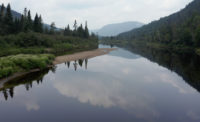Poultry Perspectives
'Waters of the U.S.' controversy still roils

Any time a government agency seeks to advance regulation that can affect a property owner’s rights, controversy is inevitable. So it is for the Environmental Protection Agency’s (EPA) recently published “Clean Water Rule: Definition of ‘Waters of the United States.’” Roughly 14 months after proposing the rule and assuring the public the purpose of the rule was to bring clarity to the limit of the agency’s jurisdictional authority, the EPA published the rule only to find the controversy has not subsided.
No one in the regulated community should question the EPA’s authority to enforce the Clean Water Act (CWA). When drafting the CWA, Congress assigned the responsibility of enforcing the federal law to the agency. Likewise, Congress authorized the EPA to develop regulations to assist the agency with achieving the act’s objective to “restore and maintain the chemical, physical, and biological integrity of the nation’s waters.” The agency does this by identifying instances, in its opinion, where federal law is not being followed adequately. Finding a solution to correct these perceived shortcomings sometimes leads an agency to presume Congress’ intention regarding the extent of the agency’s jurisdictional authority. While this is legitimate, it often adds to the controversy.
In a perfect world, the methodology for composing a new regulation follows a systematic process in which agencies justify their development by citing robust science and impartially evaluating benefits and costs. Once the regulation has been proposed, stakeholders are given an opportunity to comment, again using science, personal experience and economic rationale as a basis for their position. Agencies are required to review and consider public comments as they proceed with determining the regulation’s content and reach. While the regulated community may not agree with the final regulation, the process gives stakeholders an opportunity to participate in a process that is expected to be transparent and objective.
Until this spring, controversy surrounding the Clean Water Rule centered in the EPA’s jurisdictional authority, specifically what type of water, drainage and land features fall under the agency’s jurisdiction as it enforces the Clean Water Act. Many believe the Clean Water Rule will greatly expand the EPA’s jurisdiction to areas that were never meant to be regulated. That controversy still exists, and it is unlikely that it will go away if the current rule remains in force.
Additional controversy, which was a product of its own actions, fell on the EPA this spring. During her testimony to a Senate committee in March, the EPA administrator informed the committee the agency had received more than 1 million comments on the Clean Water Rule, and roughly 87 percent favored the rule. What the administrator failed to share was the EPA’s role in acquiring that level of favoritism.
Instead of allowing the science to support the rule, the EPA engaged in a lobbying campaign with environmental groups through social-media tools such as Facebook and Twitter to garner support for the rule. Many speculate the agency engaged in the process to solicit comments favorable to the rule to offset the wide-ranging, negative feedback it was receiving.
The agency’s proactive petition for support from organizations with a visible agenda is a discouraging example to many of this administration’s desire to advance regulation at any cost. NP
Looking for a reprint of this article?
From high-res PDFs to custom plaques, order your copy today!





